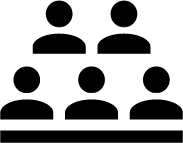The terms and language used in the trade show industry can be quite confusing and a bit overwhelming for novice trade show exhibitors. Fortunately, it only takes one or two trade shows to learn the basics of trade show marketing. To help make things a little easier, we’ve put together a list of the most commonly used trade show terms and their definitions. Be sure to go over this glossary before you exhibit at your next trade show!
Advance warehouse: An off-site warehouse, where exhibitors’ show materials are stored until show setup begins. Items are shipped to the advanced warehouse a few weeks before the start of the event, then a show contractor transports the items from the warehouse to the show site. Advanced warehousing is usually a much less expensive option than direct-to-show shipping, but requires advanced planning to meet the required delivery windows.
Backlighting: Backlit graphics contain rear illumination lighting that creates a higher impact visual image.
Banner stand: Free-standing display hardware that’s paired with flexible graphics. The graphics are usually manufactured from fabric or vinyl.
Boneyard: An area used for storage of equipment and supplies (such as shipping cases) during a trade show or event. A boneyard may have its own dedicated space in the exhibit hall, or it may be located on an unused portion of the show floor.
Custom display/exhibit: Custom displays are designed and fabricated without relying on prefabricated elements or components. This generally includes wood laminate booths but also includes the use of many aluminum extrusion components and other building materials. These displays always require professional setup.
CWT: Hundredweight. The unit used in material handling services. Exhibitors are charged in units of 100 lbs, rounded up to the next hundred. The “C” in CWT represents the Roman numeral for 100, and “WT” stands for weight.
EAC (Exhibitor appointed contractor): The outside contractors who specialize in installation and dismantling.
Decorator: A company contracted by show management that is responsible for the labor, drayage, signage, installation, decoration, and dismantling of exhibits at the show.
Drayage: Drayage is the term for the handling of exhibit materials from the dock at the show location to the exhibitor’s booth within the show hall. Trade show participants pay a fee, based on the weight and number of packages, to have their show materials received at the dock and moved to their individual show space.
End cap: An exhibit space with aisles on three sides.
Header: A sign or other structure across the top of the exhibit.
Hybrid exhibit: The typical hybrid consists of aluminum extrusion, tension fabric graphics, and custom or modular components. Each manufacturer defines hybrid exhibits slightly differently and many refer to them as custom hybrid or modular hybrid displays. Hybrid exhibits are the fastest growing segment in the trade show exhibit industry.
I&D: Installation and dismantling is the term given to the labor required to set up, take down, and repack an exhibit. I&D rules and rates vary depending on the show hall and show management.
Inline Display: Inline displays face one or two aisles in a continuous line. Typical inline displays are 10’ x 10’ and 10’ x 20’.
Island exhibit: A display with aisles on four sides.
Marshaling: Marshaling refers to the sequential staging of freight carriers waiting at the show freight yard for freight to be unloaded or loaded.
Modular: Modular exhibits consist of independent, interchangeable components that can be used in a number of different configurations.
Portable: A portable display is any booth light enough to be transported without a dolly, pallet jack, or forklift. Historically, portable has been synonymous with any packaging that meets UPS guidelines. Most portable booths were engineered to pack in cases that were within UPS guidelines. Currently portable refers to the size of the components, as portable systems often include display elements that require larger molded tub cases or even wood crates.
Service Kit: A packet of show-related information and order forms provided to exhibitors by show management. Also called Exhibitor Kit.
Show Manager: The organizer and operator of an exposition.
Show Services: the company contracted by trade show producers to offer all services, such as carpentry, furnishings, and catering.
Steward: Steward is the title given to the lead position of the union labor manager. This is the show floor boss who manages the labor and ensures that exhibitors follow show regulations.
Teardown: The dismantling of an exhibit.
At your next trade show, keep an eye out for these five up-and-coming show trends!
Learn more about how Trade Show Infotainer can help you make the most out of your next exhibition by checking out our services page.




